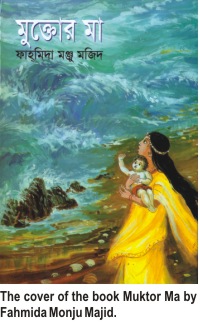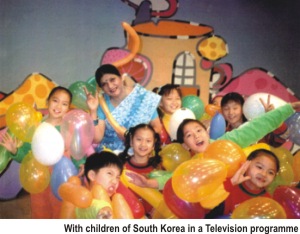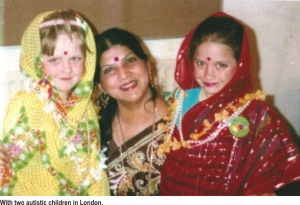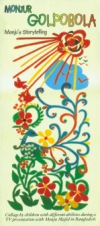|
Personality
Storytelling
as a Learning Tool
Novera
Deepita
 Once
in a session with children at the Commonwealth Institute in
London, a Gujrati girl asked Fahmida Monju Majid, 'What is
your religion?' The question was inspired by Monju's story
that used props representing different religions. Monju smiled,
'Well, I was born a Muslim.' Being curious the girl drew nearer
and whispered in Monju's ears, 'What are you now?' 'I am a
human being,' was the reply. The girl hugged Monju with a
smile and said, 'I am, too. This is the best religion.' Once
in a session with children at the Commonwealth Institute in
London, a Gujrati girl asked Fahmida Monju Majid, 'What is
your religion?' The question was inspired by Monju's story
that used props representing different religions. Monju smiled,
'Well, I was born a Muslim.' Being curious the girl drew nearer
and whispered in Monju's ears, 'What are you now?' 'I am a
human being,' was the reply. The girl hugged Monju with a
smile and said, 'I am, too. This is the best religion.'
This is
how Fahmida Monju Majid, the only professional storyteller
of the country, describes how broad a child's psychological
horizon can be. Involved with activities on the psychological
development of children since 1965, Monju works to help children
project their latent talent and abilities. She also teaches
them moral values and necessary social skills. Through storytelling
she tries to ensure these basic lessons of life.
According
to Monju, 'The importance of storytelling has been recognised
by recent scientific research. Stories, told in an attractive
manner, could be one of the best communicators for children.'
And Monju has turned storytelling into an art as she uses
instrumental and vocal sound effects, paintings, dramas, gigs,
puppets and other props that appeal to children.
Monju
prefers to tell stories at a pace easy for children to understand
and enjoy. Her style also differs from the ordinary rendition
of story telling. She describes an occasion: A puppet named
Khukumoni introduces Monju on the stage. She takes several
props with her. One of her props is a mask of a ghost, which
she has made herself in such a simple manner so that a child
can have the feeling that s/he can also make it. Sometimes
Monju imitates a monster that shouts at the prince, 'Fi-fy-fo-fum!
I smell the blood of a British man!' Sometimes she is the
bee with a hard-to-hear voice. She sometimes becomes the fairy
complete with wings. Through voice modulation she makes different
sound effects to match the theme of the story.
Monju
has conducted hundreds of storytelling sessions abroad and
uses sarees as props with which she portrays different things--a
sea with a blue saree, grass with a green one and the sun
with a golden one. With her teep on the forehead, fresh flowers
in her hair, draping Dhakai saree and glass bangles in her
hands she always presents herself as a traditional Bangalee.
 She
tells the stories from Aesop's Fables, traditional folk or
fairy tales in the improvised version and even she makes up
stories on her own to teach the children some basic things.
For instance, she tells a story about circles and squares
to teach elementary geometry. Written by Monju, the story
is about a group of squares that used to make fun of the circles
saying, 'You are not that smart and beautiful because you
don't have edges like us.' So, the circles try to find ways
to change the notion of the squares. She
tells the stories from Aesop's Fables, traditional folk or
fairy tales in the improvised version and even she makes up
stories on her own to teach the children some basic things.
For instance, she tells a story about circles and squares
to teach elementary geometry. Written by Monju, the story
is about a group of squares that used to make fun of the circles
saying, 'You are not that smart and beautiful because you
don't have edges like us.' So, the circles try to find ways
to change the notion of the squares.
Monju
believes that children with special needs like the autistic
children and children in uncommon circumstances need physical
support or 'touch therapy'-- interactive sessions of story
telling. In a television programme in London, she was once
told not to hug and kiss the participating children. Monju
contradicted asking the producer, 'Don't you hug and kiss
your kids when you go home?' She explained to him how important
it is for the children as they find support and shelter through
affectionate touch.
Monju
feels that children can be made responsible through entertainment.
For example, if she wants the children to sweep the floor,
she asks them, 'What do we need to clean the dirt?' Maybe,
the children answered, 'A hand and a broom'; she then asks,
'What else do we need?' The children might look at each other
and wonder what would it be. With a giggle she shouts in joy,
'We need the wish to do this," which is the most important
thing because without it we cannot complete the task.' Then
with the enthusiastic participation of the children the work
is done!
About
the therapeutic use of storytelling Monju says, 'This is a
very effective technique to deal with children with social
and physical difficulties.' Therapeutic stories give messages
that deal directly with the unconscious mind of the listeners
with directives about love, power and healing. She asserts
that physically and mentally challenged children can be treated
through such therapy. Game therapy, for example, for average
children and touch therapy for the visually challenged can
have positive effects. She says, 'By adapting characters like
Ivan of the Russian fairytales who was very brave and Little
Red Riding Hood who suffered for not listening to her parents,
children can learn, realise and feel what is right and how
to do it.'
 Monju
emphasises on this special technique: 'When all the child's
wishful thinking gets embodied in a good fairy, all his or
her destructive wishes in an evil witch, all his fears in
a voracious wolf, all the demands of the conscience in an
encounter on an adventure, all his jealous anger in some animal
that pecks out the eyes of his arch rival--then the child
can finally begin sorting out his contradictory tendencies.
Once this starts, the child will be least and least engulfed
by unmanageable chaos.' Monju
emphasises on this special technique: 'When all the child's
wishful thinking gets embodied in a good fairy, all his or
her destructive wishes in an evil witch, all his fears in
a voracious wolf, all the demands of the conscience in an
encounter on an adventure, all his jealous anger in some animal
that pecks out the eyes of his arch rival--then the child
can finally begin sorting out his contradictory tendencies.
Once this starts, the child will be least and least engulfed
by unmanageable chaos.'
For hearing
impaired children, the therapeutic use of pictures can make
them understand how the instruments play music and what is
sweet music. Monju says, 'When I tell stories to the children
who cannot walk, I do not say that the prince of the story
was running and chasing the monster to kill him. I'd say the
prince was flying instead.'
 Monju,
who has specialisation in child psychology, has written several
books of fiction, fairy tales and poems. She also has been
conducting integration programmes since 1965. She explains
what is an integration programme: 'We put different things
together to make the children understand things they should
learn. There are no prejudices in such programmes.' Such integration
programmes include interactive sessions with children with
lots of paintings, puppets and other representative props. Monju,
who has specialisation in child psychology, has written several
books of fiction, fairy tales and poems. She also has been
conducting integration programmes since 1965. She explains
what is an integration programme: 'We put different things
together to make the children understand things they should
learn. There are no prejudices in such programmes.' Such integration
programmes include interactive sessions with children with
lots of paintings, puppets and other representative props.
Monju
is a registered storyteller of the Commonwealth Institute,
a regular host of programmes on the BBC radio and various
other television programmes on children. The granddaughter
of poet Gulam Mustafa and the niece of celebrated puppeteer
Mustafa Monowar, Monju considers her birth in such a family
as a blessing.
Emphasising
on the three P's of child rights, Protection, Provision and
Participation, Monju feels it is important for a child to
learn with interest. She boldly says, 'Education with entertainment
is more efficient than the old fashioned didactic system.
Copyright
(R) thedailystar.net 2004
| 